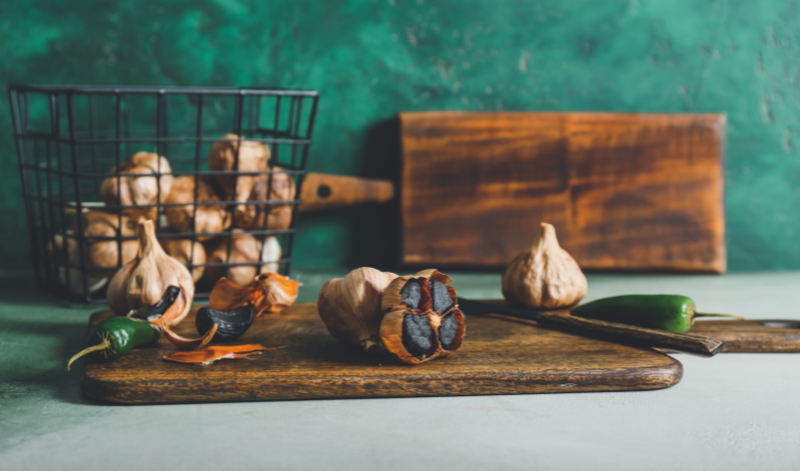If you’ve ever bitten into a soft clove of black garlic and wondered how it achieves such a sweet, savory punch, you’re not alone. Perfecting black garlic is a balancing act that combines tradition and cutting-edge technique—and it’s as much an art as it is a science. Below, we’ll take you on a journey through the careful steps that transform ordinary garlic bulbs into black garlic’s jammy, flavor-packed cloves.
Selecting the Right Garlic
Quality is Non-Negotiable
The first step begins before we even start the aging process. Every bulb needs to meet certain standards:
-
Freshness: We choose young, plump bulbs free of bruises or mold.
-
Variety: Different garlic varieties yield different flavors. Hardneck vs. softneck can affect everything from clove size to sweetness levels.
-
Consistency: Uniform bulbs ensure more predictable aging results.
Many black garlic enthusiasts and producers have their own “go-to” garlic type—some prefer larger heads for bigger, meatier cloves, while others opt for smaller, more intensely flavored bulbs.
The Aging Environment
Temperature & Humidity
Black garlic forms when fresh garlic is kept in a controlled setting of low heat and high humidity, typically around 60–90 °C (140–190 °F) and humidity levels around 80–90%. The exact specs can vary, but consistent conditions are vital.
What Happens?
-
Enzymatic Reactions: Natural enzymes in garlic begin to break down proteins and sugars.
-
Maillard Reaction: The same chemical process that browns your steak or caramelizes onions. This develops the “brown” pigments that eventually turn the cloves black.
-
Sulfur Changes: Pungent raw garlic compounds (like allicin) transform into less-harsh sulfur compounds, smoothing out the flavor.
Why It Matters: Even small fluctuations in temperature or humidity can alter the aging trajectory. Too hot or too long, and the cloves might become bitter or tough. Too cool or too short, and they won’t fully darken and sweeten.
The Art of Timing
Weeks of Patience
Unlike quick-cooking methods, black garlic demands time—often 2 to 6 weeks of steady aging.
-
Early Days: The cloves gradually lose some moisture, concentrating their natural sugars.
-
Mid-Process: Sweetness deepens, and the color moves from light brown to a deeper caramel.
-
Final Stretch: Cloves darken to a nearly black hue, their texture becoming soft, sticky, and jammy.
Throughout, seasoned producers will check on the garlic, sometimes sniffing the air or peeking at a test bulb. Experience informs when the garlic’s at peak transformation.
Monitoring & Adjusting
Small But Crucial Tweaks
Professional producers might use specialized fermenters or sealed cabinets with built-in humidifiers and thermostats. Even home cooks rely on rice cookers or slow cookers to maintain consistent warmth.
-
Turning or Rotating: Some practices involve flipping bulbs occasionally to ensure even exposure.
-
Moisture Checks: If the environment becomes too dry, cloves can harden. Too wet, and they risk mold.
-
Taste Tests: The ultimate gauge is sampling a clove—looking for that sweet-savory balance.
Chemistry Meets Craft
The Maillard Reaction at Work
While the Maillard reaction is science, the process also feels somewhat magical:
-
Sugars + Amino Acids = Flavor Complexity: This reaction generates new flavor molecules, each adding another layer of complexity.
-
Reduced Harshness: Raw garlic’s stinging allicin diminishes significantly, replaced by gentler, roasted undertones.
-
Dark Pigments (Melanoidins): These not only color the garlic black but also contribute to its soft texture.
Balancing the Variables: Achieving that perfect softness and flavor intensity is akin to tweaking a recipe—time, heat, humidity, bulb variety, and even altitude can have subtle effects.
Quality Control & Post-Aging Care
Preservation & Storage
Once the aging phase is complete, we carefully cool the bulbs and inspect them:
-
Texture Check: Cloves should yield slightly to pressure, like sticky raisins.
-
Flavor Profile: A good batch balances caramel sweetness with a gentle tang.
-
Shelf Life: Properly sealed, black garlic can last for months without losing much flavor.
In commercial settings, producers might vacuum-seal or pack black garlic in jars to preserve freshness. Home cooks can store bulbs or peeled cloves in an airtight container in the fridge.
Why It’s Worth the Effort
Culinary Versatility
Once you have perfectly aged black garlic, the uses are nearly endless:
-
Mashed into Compound Butters for steaks, breads, or roasted vegetables.
-
Blended into Sauces like tomato sauces, cream sauces, or even barbecue glazes.
-
Added to Hummus or dips for a sweet-savory twist.
-
Swirled into Desserts (think chocolate or caramel) for an unexpected umami dimension.
Health Notes
Black garlic also garners attention for its possible health benefits:
-
High in Antioxidants: Some studies suggest black garlic may pack more antioxidants than raw garlic.
-
Easier on Digestion: The aging process mellows sulfur compounds, often making it gentler for those who find raw garlic too strong.
Final Thoughts
Perfecting black garlic is truly both an art and a science—balancing precise temperature, humidity, and time while maintaining a watchful, intuitive eye. The end result is nothing short of remarkable: a richly flavorful clove that can enhance recipes across cuisines without the bite of raw garlic. Whether you’re a culinary pro or an adventurous home cook, taking the time to master or source well-aged black garlic is a game-changer for your kitchen.
So next time you bite into a sticky, sweet black garlic clove, remember the careful orchestration behind it. The layers of science, tradition, and patient craftsmanship all come together in that one delicious, umami-packed moment.

Comments (0)
No comments yet. Be the first to comment!